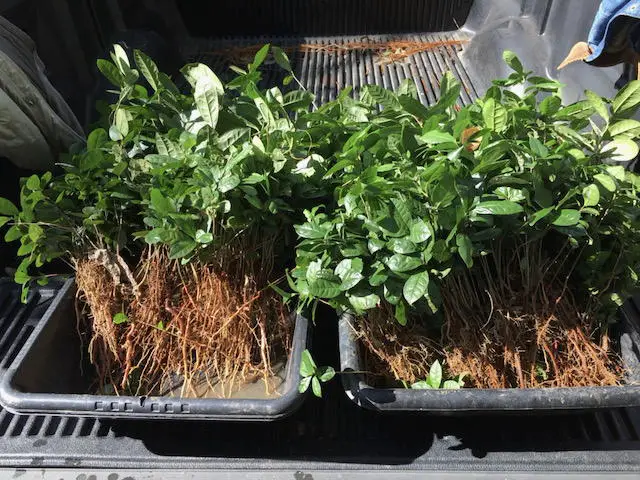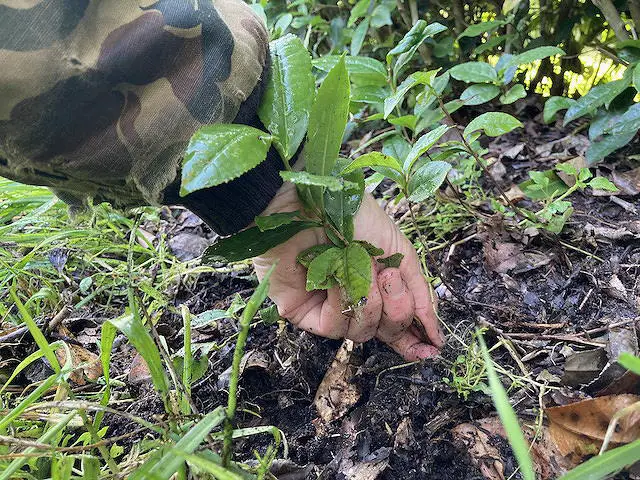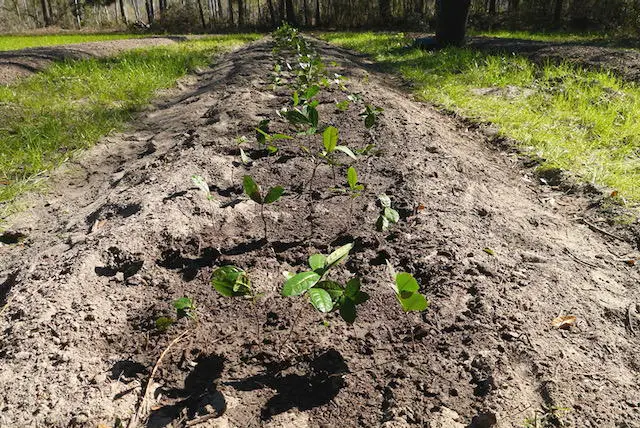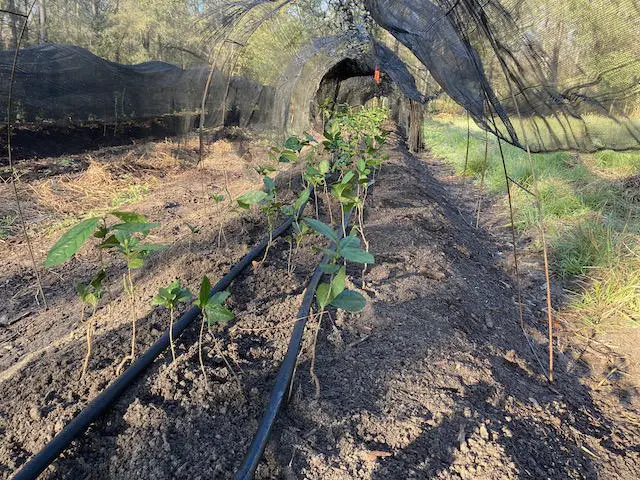Planting bare-root tea seedlings is probably the cheapest and fastest way to get your Camellia sinensis garden up and running.
It’s cheap for two reasons. First, you skip the costs of growing tea seeds or tea cuttings in plastic pots for at least a year. Instead, you harvest tea seedlings without soil in one field and transplant them directly into another. Second, there’s no intermediate step in a greenhouse to add expense.
And it’s fast because you can shave a year or more off the five-year wait to reach the maximum yield of tea leaves. The sooner your plants mature, the sooner you can begin manufacturing delicious tea.
Of course, there are tricks to gardening with bare-root tea, and today, I’ll share what I’ve learned from my own experience with this remarkable resource.
Let’s start with when and how to harvest C. sinensis in the bare-root condition.

When to Harvest Tea Seedlings, Bare-root
You can harvest tea seedlings from the field at any time of the year, but not all seasons are suitable for transplanting.
For example, I grow tea in the Red Hills Region of northern Florida, where I transplant seedlings in the early spring. Other growers at nearly the same geographic latitude transplant in late summer.
When I plant, winter and spring rains help seedlings recover from the shock of being pulled from the ground by their tops. And in the late summer, torrential rainfall saturates the soil and has the same benefit to seedlings.
The hot, dry, and cloudless days of May through June can be pretty rough on seedlings, so I neither harvest nor transplant at that time.
The point is to choose the time of year for your region that’s best for plant recovery and your schedule, and then harvest seedlings for that particular season.
I’ll have more to say below about how to give your tea a fighting chance in any season.
How to Harvest Tea Seedlings
My preference is for seedlings that are at least six inches tall above ground and have four or more healthy leaves. Such seedlings are usually a year and a half old and possibly older.
Damp soil will yield seedlings more readily than dry soil, so try to harvest after heavy rainfall or a good soaking with irrigation.
Also, a little bit of soil will stick to the roots, which will hold moisture and perhaps beneficial soil microbes. But usually, your seedlings will be surprisingly free of any earth, which is why they’re called bare-root.
The procedure for collecting seedlings is straightforward: grasp the plant at soil level and make a steady but firm pull upwards. Try to keep the root and main stem connected and intact. It’s a fine balance between brute force and gentle patience, but you’ll figure it out after feeling the anguish of breaking a few stems.
Pulling seedlings can be hard on the back, so bring some other backs to share the workload. And good gloves will protect your hands from blisters.
By the way, don’t bother digging seedlings with a shovel. The tea garden owner won’t appreciate dozens or hundreds of little holes dug about.

How Many Tea Seedlings Should You Harvest?
Tea seedlings are not identical copies of each other. Instead, they vary genetically, meaning some losers will be mixed among winners, and you can’t always tell them apart when plants are young and small.
To offset uncertainty in plant performance, I use a high-density planting scheme. Specifically, I transplant a set of 4 to 6 seedlings every 1.5 feet across the width and along each planting bed. As tea bushes mature and you carefully prune them, neighboring plants merge their leafy canopies and transform the bed into a dense hedgerow of tea.
Number to Harvest: An Example
To estimate the number of seedlings to collect, I divide the total feet of bed by 1.5 and multiply the result by 6 (or by 4 if my budget for seedlings is tight).
I make this same calculation for each bed and sum the seedling totals among beds. To fill in a 50-foot-long bed, for example, I need at least (50÷1.5)x(6) = 200 seedlings. For three such beds, I need 600 seedlings.
That’s a lot of little plants, and with such a large number in each bed, there will always be enough strong performers to make a productive hedgerow of tea. The not-so-strong will wither away.
Moreover, you need to install a lot of plants per square foot to get enough leaf yield to manufacture tea! High density is the way to go.
To be clear, I do not recommend high-density planting of pot-grown tea with robust roots and tops. You can sort out weak potted plants from the strong so their abilities are less uncertain. Therefore, potted plants can be transplanted at lower densities (though you still need to prune and shape them into bountiful hedgerows).

How to Store Bare-root Tea Seedlings
There are two situations where you’ll need to put your tea seedlings in storage before planting: when you’re not prepared to plant or when it’s too cold to risk freeze damage.
My field is usually unprepared for planting. The reason is that I never know ahead of time the final total of seedlings that I’ll be able to gather for the next round of planting, so I wait to prep.
Of course, I know the number of beds I would like to have and their lengths, and this is how I estimate the number of seedlings I’ll need. But I never prep beds until I have seedlings in hand. By waiting, I save the expense of putting fertilizers, composts, and amendments into the ground for beds that I cannot fill with plants.
Seedlings on hold for beds have to be stored.
And if it’s too cold outside to transplant seedlings, then you have to keep them in storage until the risk of damaging freeze has passed.
Keep Storage Simple
I use a large, insulated food and beverage cooler to store tea seedlings. There is room for over a thousand seedlings, which I mist to dampen but never drench. At least once a week, I open the cooler, inspect for molds, and separate out infected plants.
Though I always try to plant seedlings as soon as possible, in a few seasons, I have kept seedlings for up to six weeks in the cooler.
I monitor the temperature inside the cooler and make adjustments to keep the plants between 40 and 60°F. If a hard cold snap is on the way, try wrapping the cooler in a heated blanket or bring it indoors where it’ll stay above freezing.
You can also use an ordinary kitchen refrigerator for storage, provided you can keep the temperature above 40°F. However, a robust, two-year-old tea seedling could be about 18 inches or longer from tip to tip, so you’ll need a lot of space in the fridge.
Other growers layer their seedlings outdoors, “heeled-in” to a trench of sawdust or other coarse organic materials that are kept moist with water.
Whichever storage method you choose, don’t let the seedlings freeze!
How to Care for Bare-root Tea Seedlings
I plant tea seedlings in February and March. This means that these plants are in the ground for only a few weeks before the stress of late springtime.
Similarly, those who plant in the late summer experience the warm and arid conditions of the early fall. Therefore, there has been little time to restore roots that can endure difficult dry spells in either spring or fall.
So, if there’s a catch with using bare-root seedlings, it’s that you have to baby them a bit after planting.
Irrigate Tea for Survival, Then for Yield
In my experience, bare-root tea seedlings will not survive transplanting without lots of water. Weekly rainfall totals of 1.5 to 2 inches are adequate during the first six months after planting. Any amount less is risky and you’ll need to irrigate.
Worry not, however, because inexpensive irrigation kits will get the job done. And if your kit works for a year, then you’ve done about all you can do to improve seedling survival with irrigation.
In the second season and beyond–which in tea may be decades–you use irrigation more to boost leaf yield and less for improving survival.
I use drip irrigation and try to position emitters within a few inches of each seedling. Driplines have 1-gallon-per-hour emitters spaced every 9 inches. And as I already indicated, I plant tea every 18 inches. When you install so many emitters per foot, it doesn’t really matter if your dripline gets jostled around over time. Seedlings are never that far from the nearest water source.
I monitor ground moisture and irrigate at least two hours, twice per week, or less if there’s been good rainfall. In really sandy soils, you may have to water even more than this rate.
Shade Your Tea Seedlings
When you harvest tea seedlings, they are probably under the deep shade of their parent plants. Therefore, to protect your freshly planted tea from sunburn, you’ll need to shield them with a shade that you provide.
Indeed, sun shelters are so essential for bare-root tea that I wrote an entire post about building a shade structure.
Briefly, I “sandwich” woven shade cloth between lengths of masonry reinforcement wire that I arc over the planting bed. This design uses the arc and the pressure of the wire sandwich to keep the cloth taut along the bed.
It is a simple and effective design, but you must invest in shade cloth and masonry wire. Cloth is not cheap but if cared for properly during the off-season it will last many years.
Please study this shade system or find an alternative design as part of your budgeting and planning. Your bare-root tea won’t survive without shade.

More Tips: How to Plant Bare-root Tea
A few more points are worth keeping in mind with bare-root seedlings.
- To reduce transplant shock, don’t let the roots get dry or sunburnt while they wait to be planted. Instead, keep the seedlings sheltered and damp in a bucket or tray covered with a wet cloth.
- In the planting holes or trench, give the tea roots the depth they need without being bent or folded. You want the taproot to point straight down into the earth and not make any difficult turns.
- Back-fill soil with firm but non-aggressive packing. If the soil is too loose the seedling will fall over after soaking rains or irrigation. If you packed it too tight, the fine root hairs will have trouble growing into the earth.
- Back-fill to the collar, which is the point where the roots end and the main stem begins.
Where to Find Tea Seedlings
Ask plant nurseries with experience selling tea if they have bare-root tea seedlings. They may not advertise that they do because they’d prefer to grow them up in pots for retail sales. So, you may have to make a wholesale, high-volume deal that’s worth it to them. Expect to pay 50 cents to 2 dollars per seedling.
You can also check with established tea gardens and plantations that aren’t in the plant nursery business. Tea makes a lot of seed, so it’s likely that they will have seedlings growing under the hedges. Offer to do the work of pulling seedlings yourself or make some other trade to help them out.
Seedlings are valuable, especially for a newer tea garden like my own. Some growers may not be willing to part with the makings of future hedgerows.
Keep looking, and you’ll eventually find a grower or nursery willing to part with bare-root tea seedlings.
Happy planting!
Mike grows and crafts tea in North Florida, USA. He has advanced degrees in biology, and has undertaken coursework in manufacturing Camellia sinensis teas. Mike is a member of the US League of Tea Growers (USLTG) and has presented invited talks on tea growing. Send him a note through our Contact Page if you'd like to talk about tea.